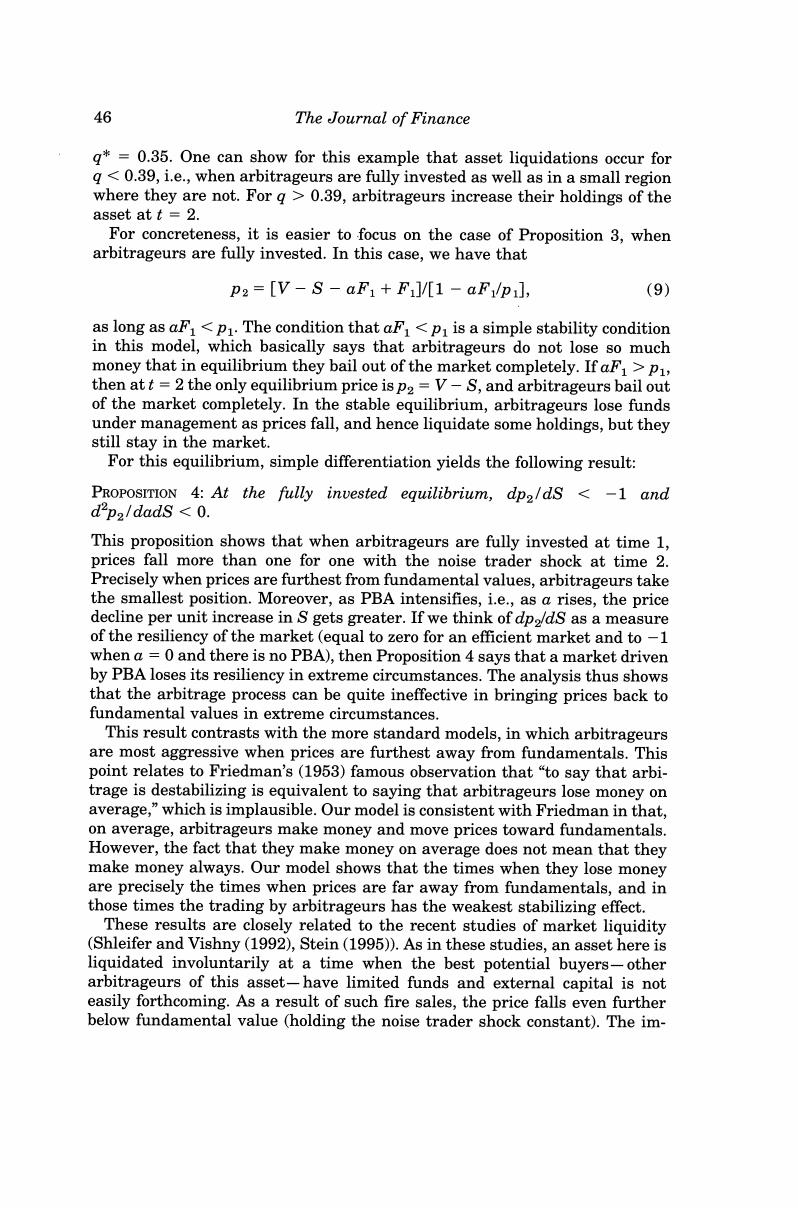正在加载图片...

46 The Journal of Finance g*=0.35.One can show for this example that asset liquidations occur for g<0.39,i.e.,when arbitrageurs are fully invested as well as in a small region where they are not.For g >0.39,arbitrageurs increase their holdings of the asset at t 2. For concreteness,it is easier to focus on the case of Proposition 3,when arbitrageurs are fully invested.In this case,we have that p2=[V-S-aF1+Fil/[1 -aF/p], (9) as long as aF<p.The condition that aF<p is a simple stability condition in this model,which basically says that arbitrageurs do not lose so much money that in equilibrium they bail out of the market completely.If aF1>p1, then att=2 the only equilibrium price is p2=V-S,and arbitrageurs bail out of the market completely.In the stable equilibrium,arbitrageurs lose funds under management as prices fall,and hence liquidate some holdings,but they still stay in the market. For this equilibrium,simple differentiation yields the following result: PROPOSITION 4:At the fully invested equilibrium,dp2/ds <-1 and d'p2/dads <0. This proposition shows that when arbitrageurs are fully invested at time 1, prices fall more than one for one with the noise trader shock at time 2. Precisely when prices are furthest from fundamental values,arbitrageurs take the smallest position.Moreover,as PBA intensifies,i.e.,as a rises,the price decline per unit increase in S gets greater.If we think of dp2/dS as a measure of the resiliency of the market (equal to zero for an efficient market and to-1 when a =0 and there is no PBA),then Proposition 4 says that a market driven by PBA loses its resiliency in extreme circumstances.The analysis thus shows that the arbitrage process can be quite ineffective in bringing prices back to fundamental values in extreme circumstances. This result contrasts with the more standard models,in which arbitrageurs are most aggressive when prices are furthest away from fundamentals.This point relates to Friedman's(1953)famous observation that"to say that arbi- trage is destabilizing is equivalent to saying that arbitrageurs lose money on average,"which is implausible.Our model is consistent with Friedman in that, on average,arbitrageurs make money and move prices toward fundamentals. However,the fact that they make money on average does not mean that they make money always.Our model shows that the times when they lose money are precisely the times when prices are far away from fundamentals,and in those times the trading by arbitrageurs has the weakest stabilizing effect. These results are closely related to the recent studies of market liquidity (Shleifer and Vishny(1992),Stein(1995)).As in these studies,an asset here is liquidated involuntarily at a time when the best potential buyers-other arbitrageurs of this asset-have limited funds and external capital is not easily forthcoming.As a result of such fire sales,the price falls even further below fundamental value (holding the noise trader shock constant).The im-